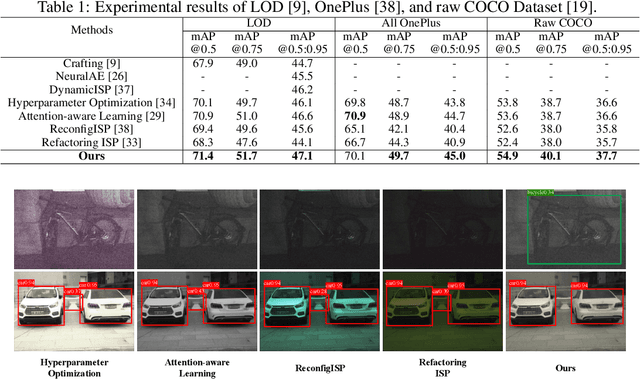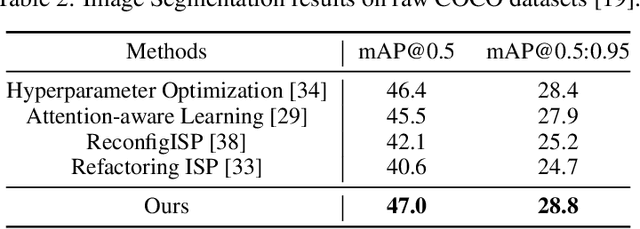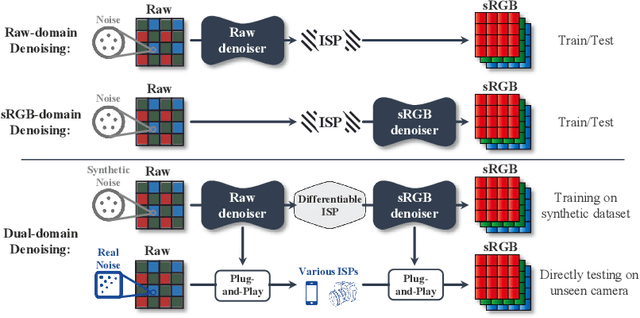Jinwei Gu
ToonComposer: Streamlining Cartoon Production with Generative Post-Keyframing
Aug 14, 2025Abstract:Traditional cartoon and anime production involves keyframing, inbetweening, and colorization stages, which require intensive manual effort. Despite recent advances in AI, existing methods often handle these stages separately, leading to error accumulation and artifacts. For instance, inbetweening approaches struggle with large motions, while colorization methods require dense per-frame sketches. To address this, we introduce ToonComposer, a generative model that unifies inbetweening and colorization into a single post-keyframing stage. ToonComposer employs a sparse sketch injection mechanism to provide precise control using keyframe sketches. Additionally, it uses a cartoon adaptation method with the spatial low-rank adapter to tailor a modern video foundation model to the cartoon domain while keeping its temporal prior intact. Requiring as few as a single sketch and a colored reference frame, ToonComposer excels with sparse inputs, while also supporting multiple sketches at any temporal location for more precise motion control. This dual capability reduces manual workload and improves flexibility, empowering artists in real-world scenarios. To evaluate our model, we further created PKBench, a benchmark featuring human-drawn sketches that simulate real-world use cases. Our evaluation demonstrates that ToonComposer outperforms existing methods in visual quality, motion consistency, and production efficiency, offering a superior and more flexible solution for AI-assisted cartoon production.
Cosmos-Reason1: From Physical Common Sense To Embodied Reasoning
Mar 18, 2025Abstract:Physical AI systems need to perceive, understand, and perform complex actions in the physical world. In this paper, we present the Cosmos-Reason1 models that can understand the physical world and generate appropriate embodied decisions (e.g., next step action) in natural language through long chain-of-thought reasoning processes. We begin by defining key capabilities for Physical AI reasoning, with a focus on physical common sense and embodied reasoning. To represent physical common sense, we use a hierarchical ontology that captures fundamental knowledge about space, time, and physics. For embodied reasoning, we rely on a two-dimensional ontology that generalizes across different physical embodiments. Building on these capabilities, we develop two multimodal large language models, Cosmos-Reason1-8B and Cosmos-Reason1-56B. We curate data and train our models in four stages: vision pre-training, general supervised fine-tuning (SFT), Physical AI SFT, and Physical AI reinforcement learning (RL) as the post-training. To evaluate our models, we build comprehensive benchmarks for physical common sense and embodied reasoning according to our ontologies. Evaluation results show that Physical AI SFT and reinforcement learning bring significant improvements. To facilitate the development of Physical AI, we will make our code and pre-trained models available under the NVIDIA Open Model License at https://github.com/nvidia-cosmos/cosmos-reason1.
Cosmos-Transfer1: Conditional World Generation with Adaptive Multimodal Control
Mar 18, 2025Abstract:We introduce Cosmos-Transfer, a conditional world generation model that can generate world simulations based on multiple spatial control inputs of various modalities such as segmentation, depth, and edge. In the design, the spatial conditional scheme is adaptive and customizable. It allows weighting different conditional inputs differently at different spatial locations. This enables highly controllable world generation and finds use in various world-to-world transfer use cases, including Sim2Real. We conduct extensive evaluations to analyze the proposed model and demonstrate its applications for Physical AI, including robotics Sim2Real and autonomous vehicle data enrichment. We further demonstrate an inference scaling strategy to achieve real-time world generation with an NVIDIA GB200 NVL72 rack. To help accelerate research development in the field, we open-source our models and code at https://github.com/nvidia-cosmos/cosmos-transfer1.
A Physics-Informed Blur Learning Framework for Imaging Systems
Feb 17, 2025Abstract:Accurate blur estimation is essential for high-performance imaging across various applications. Blur is typically represented by the point spread function (PSF). In this paper, we propose a physics-informed PSF learning framework for imaging systems, consisting of a simple calibration followed by a learning process. Our framework could achieve both high accuracy and universal applicability. Inspired by the Seidel PSF model for representing spatially varying PSF, we identify its limitations in optimization and introduce a novel wavefront-based PSF model accompanied by an optimization strategy, both reducing optimization complexity and improving estimation accuracy. Moreover, our wavefront-based PSF model is independent of lens parameters, eliminate the need for prior knowledge of the lens. To validate our approach, we compare it with recent PSF estimation methods (Degradation Transfer and Fast Two-step) through a deblurring task, where all the estimated PSFs are used to train state-of-the-art deblurring algorithms. Our approach demonstrates improvements in image quality in simulation and also showcases noticeable visual quality improvements on real captured images.
Tolerance-Aware Deep Optics
Feb 07, 2025Abstract:Deep optics has emerged as a promising approach by co-designing optical elements with deep learning algorithms. However, current research typically overlooks the analysis and optimization of manufacturing and assembly tolerances. This oversight creates a significant performance gap between designed and fabricated optical systems. To address this challenge, we present the first end-to-end tolerance-aware optimization framework that incorporates multiple tolerance types into the deep optics design pipeline. Our method combines physics-informed modelling with data-driven training to enhance optical design by accounting for and compensating for structural deviations in manufacturing and assembly. We validate our approach through computational imaging applications, demonstrating results in both simulations and real-world experiments. We further examine how our proposed solution improves the robustness of optical systems and vision algorithms against tolerances through qualitative and quantitative analyses. Code and additional visual results are available at openimaginglab.github.io/LensTolerance.
Parallel Sequence Modeling via Generalized Spatial Propagation Network
Jan 21, 2025



Abstract:We present the Generalized Spatial Propagation Network (GSPN), a new attention mechanism optimized for vision tasks that inherently captures 2D spatial structures. Existing attention models, including transformers, linear attention, and state-space models like Mamba, process multi-dimensional data as 1D sequences, compromising spatial coherence and efficiency. GSPN overcomes these limitations by directly operating on spatially coherent image data and forming dense pairwise connections through a line-scan approach. Central to GSPN is the Stability-Context Condition, which ensures stable, context-aware propagation across 2D sequences and reduces the effective sequence length to $\sqrt{N}$ for a square map with N elements, significantly enhancing computational efficiency. With learnable, input-dependent weights and no reliance on positional embeddings, GSPN achieves superior spatial fidelity and state-of-the-art performance in vision tasks, including ImageNet classification, class-guided image generation, and text-to-image generation. Notably, GSPN accelerates SD-XL with softmax-attention by over $84\times$ when generating 16K images.
Cosmos World Foundation Model Platform for Physical AI
Jan 07, 2025



Abstract:Physical AI needs to be trained digitally first. It needs a digital twin of itself, the policy model, and a digital twin of the world, the world model. In this paper, we present the Cosmos World Foundation Model Platform to help developers build customized world models for their Physical AI setups. We position a world foundation model as a general-purpose world model that can be fine-tuned into customized world models for downstream applications. Our platform covers a video curation pipeline, pre-trained world foundation models, examples of post-training of pre-trained world foundation models, and video tokenizers. To help Physical AI builders solve the most critical problems of our society, we make our platform open-source and our models open-weight with permissive licenses available via https://github.com/NVIDIA/Cosmos.
NVComposer: Boosting Generative Novel View Synthesis with Multiple Sparse and Unposed Images
Dec 04, 2024



Abstract:Recent advancements in generative models have significantly improved novel view synthesis (NVS) from multi-view data. However, existing methods depend on external multi-view alignment processes, such as explicit pose estimation or pre-reconstruction, which limits their flexibility and accessibility, especially when alignment is unstable due to insufficient overlap or occlusions between views. In this paper, we propose NVComposer, a novel approach that eliminates the need for explicit external alignment. NVComposer enables the generative model to implicitly infer spatial and geometric relationships between multiple conditional views by introducing two key components: 1) an image-pose dual-stream diffusion model that simultaneously generates target novel views and condition camera poses, and 2) a geometry-aware feature alignment module that distills geometric priors from dense stereo models during training. Extensive experiments demonstrate that NVComposer achieves state-of-the-art performance in generative multi-view NVS tasks, removing the reliance on external alignment and thus improving model accessibility. Our approach shows substantial improvements in synthesis quality as the number of unposed input views increases, highlighting its potential for more flexible and accessible generative NVS systems.
AdaptiveISP: Learning an Adaptive Image Signal Processor for Object Detection
Oct 30, 2024



Abstract:Image Signal Processors (ISPs) convert raw sensor signals into digital images, which significantly influence the image quality and the performance of downstream computer vision tasks. Designing ISP pipeline and tuning ISP parameters are two key steps for building an imaging and vision system. To find optimal ISP configurations, recent works use deep neural networks as a proxy to search for ISP parameters or ISP pipelines. However, these methods are primarily designed to maximize the image quality, which are sub-optimal in the performance of high-level computer vision tasks such as detection, recognition, and tracking. Moreover, after training, the learned ISP pipelines are mostly fixed at the inference time, whose performance degrades in dynamic scenes. To jointly optimize ISP structures and parameters, we propose AdaptiveISP, a task-driven and scene-adaptive ISP. One key observation is that for the majority of input images, only a few processing modules are needed to improve the performance of downstream recognition tasks, and only a few inputs require more processing. Based on this, AdaptiveISP utilizes deep reinforcement learning to automatically generate an optimal ISP pipeline and the associated ISP parameters to maximize the detection performance. Experimental results show that AdaptiveISP not only surpasses the prior state-of-the-art methods for object detection but also dynamically manages the trade-off between detection performance and computational cost, especially suitable for scenes with large dynamic range variations. Project website: https://openimaginglab.github.io/AdaptiveISP/.
DualDn: Dual-domain Denoising via Differentiable ISP
Sep 27, 2024



Abstract:Image denoising is a critical component in a camera's Image Signal Processing (ISP) pipeline. There are two typical ways to inject a denoiser into the ISP pipeline: applying a denoiser directly to captured raw frames (raw domain) or to the ISP's output sRGB images (sRGB domain). However, both approaches have their limitations. Residual noise from raw-domain denoising can be amplified by the subsequent ISP processing, and the sRGB domain struggles to handle spatially varying noise since it only sees noise distorted by the ISP. Consequently, most raw or sRGB domain denoising works only for specific noise distributions and ISP configurations. To address these challenges, we propose DualDn, a novel learning-based dual-domain denoising. Unlike previous single-domain denoising, DualDn consists of two denoising networks: one in the raw domain and one in the sRGB domain. The raw domain denoising adapts to sensor-specific noise as well as spatially varying noise levels, while the sRGB domain denoising adapts to ISP variations and removes residual noise amplified by the ISP. Both denoising networks are connected with a differentiable ISP, which is trained end-to-end and discarded during the inference stage. With this design, DualDn achieves greater generalizability compared to most learning-based denoising methods, as it can adapt to different unseen noises, ISP parameters, and even novel ISP pipelines. Experiments show that DualDn achieves state-of-the-art performance and can adapt to different denoising architectures. Moreover, DualDn can be used as a plug-and-play denoising module with real cameras without retraining, and still demonstrate better performance than commercial on-camera denoising. The project website is available at: https://openimaginglab.github.io/DualDn/
 Add to Chrome
Add to Chrome Add to Firefox
Add to Firefox Add to Edge
Add to Edge